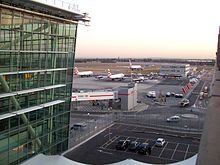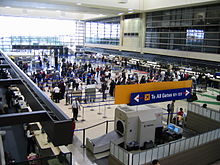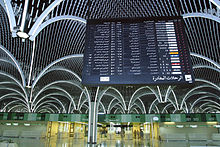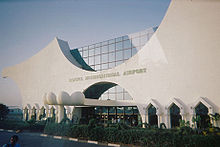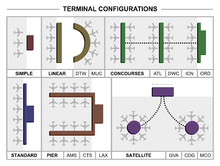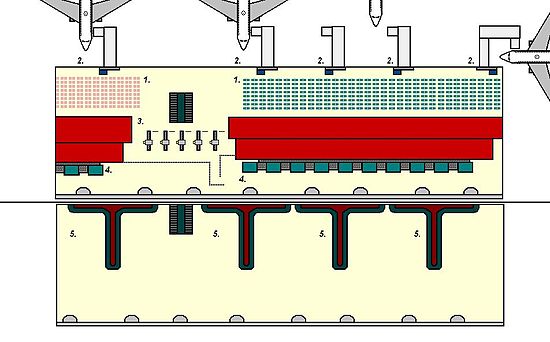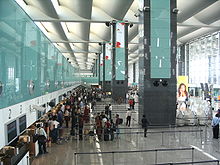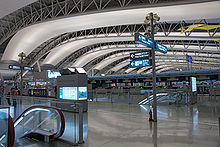- Airport terminal
-
For other uses, see Terminal (disambiguation).Terminal 5 at London Heathrow Airport, United Kingdom, which is the world's busiest airport by international passenger traffic[1]
 The Tom Bradley International Terminal of Los Angeles International Airport, which handles the most origin and destination (O&D) flights in the world
The Tom Bradley International Terminal of Los Angeles International Airport, which handles the most origin and destination (O&D) flights in the world
An airport terminal is a building at an airport where passengers transfer between ground transportation and the facilities that allow them to board and disembark from aircraft.
Within the terminal, passengers purchase tickets, transfer their luggage, and go through security. The buildings that provide access to the airplanes (via gates) are typically called concourses. However, the terms "terminal" and "concourse" are sometimes used interchangeably, depending on the configuration of the airport.
Smaller airports have one terminal while larger airports have several terminals and/or concourses. At small airports, the single terminal building typically serves all of the functions of a terminal and a concourse.
Some larger airports have one terminal that is connected to multiple concourses via walkways, sky-bridges, or underground tunnels (such as Denver International Airport). Some larger airports have more than one terminal, each with one or more concourses (such as New York's La Guardia Airport). Still other larger airports have multiple terminals each of which incorporate the functions of a concourse (such as Dallas/Fort Worth International Airport).
Most airport terminals are built in a plain style. However, some, such as Baghdad International Airport, are monumental in stature, while others are considered architectural masterpieces, such as Terminal 1 at Charles de Gaulle airport near Paris or Terminal 5 at New York's JFK Airport. A few are designed to reflect the culture of a particular area, some examples being the terminal at Albuquerque International Sunport in New Mexico, which is designed in the Pueblo Revival style popularized by architect John Gaw Meem, as well as the terminal at Bahías de Huatulco International Airport in Huatulco, Oaxaca, Mexico, which features some palapas that are interconnected to form the airport terminal.
Contents
Airport terminal designs
Due to the rapid rise in popularity of passenger flight, many early terminals were built in the 1930s–1940s and reflected the popular art deco style architecture of the time. One such surviving example from 1940 is the Houston Municipal Airport Terminal. Early airport terminals opened directly onto the tarmac: passengers would walk or take a bus to their aircraft. This design is still common among smaller airports, and even many larger airports have "bus gates" to accommodate aircraft beyond the main terminal.
Pier
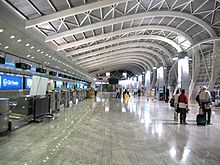 Mumbai Airport (Domestic Terminal), India
Mumbai Airport (Domestic Terminal), India
A pier design uses a long, narrow building with aircraft parked on both sides. One end connects to a ticketing and baggage claim area. Piers offer high aircraft capacity and simplicity of design, but often result in a long distance from the check-in counter to the gate (up to half a mile in the case of Kansai International Airport). Most large international airports have piers, including Chicago's O'Hare International Airport, Larnaca International Airport, Frankfurt International Airport, London Heathrow Airport, Amsterdam Schiphol Airport, Murtala Muhammed International Airport, Kuala Lumpur International Airport, Bangkok International Airport, Beirut International Airport, Hong Kong International Airport, Allama Iqbal International Airport and Miami International Airport.
Satellite terminals
A satellite terminal is a building detached from other airport buildings, so that aircraft can park around its entire circumference. The first airport to use a satellite terminal was London Gatwick Airport. It used an underground pedestrian tunnel to connect the satellite to the main terminal. This was also the first setup at Los Angeles International Airport, but it has since been converted to a pier layout. The first airport to use an automatic people mover to connect the main terminal with a satellite was Tampa International Airport, which is the standard today. Other examples include the following:
- Paris's Charles de Gaulle International Airport (Terminal 1) and London Gatwick Airport (South Terminal) both have circular satellite terminals.
- Orlando International Airport and Pittsburgh International Airport have multi-pier satellite terminals.
- Brussels Airport's Pier A is connected to the main building via underground tunnels and walkways.
- Zurich Airport's Gates E are connected with a subway.
- At Logan International Airport in Boston, Terminal A has two sections of gates, one of which is a satellite terminal connected by an underground walkway.
- Denver International Airport, General Mariano Escobedo International Airport, Cincinnati/Northern Kentucky International Airport, and Hartsfield-Jackson Atlanta International Airport have linear satellite terminals connected by central passages.
- Kuala Lumpur International Airport has a cross-shaped satellite terminal which is being used for international flights.
- Seattle-Tacoma International Airport has two rectangular satellite terminals connected by an automatic people mover system.
- Jinnah International Airport in Karachi has one main terminal, divided into two concourses: the Jinnah East Satellite Concourse, used for international flights, and the Jinnah West Satellite Concourse, used for domestic and some international flights.
- McCarran International Airport in Las Vegas has an X-shaped satellite terminal that is connected by two automatic people movers.
Semicircular terminals
Some airports use a semicircular terminal, with aircraft parked on one side and cars on the other. This design results in long walks for connecting passengers, but greatly reduces travel times between check-in and the aircraft. Airports designed around this model include Charles de Gaulle International Airport (terminal 2), Chhatrapati Shivaji International Airport, Mumbai (terminal 2), Dallas/Fort Worth International Airport, Seoul's Incheon International Airport, Toronto Pearson Airport, Kansas City Airport and Sapporo's New Chitose Airport.
Other
One rarer terminal design is the mobile lounge, where passengers are transported from the gate to their aircraft in a large vehicle which docks directly to the terminal and the aircraft. Washington Dulles International Airport, Mexico City International Airport, and Mirabel International Airport have used this design.
Hybrid layouts also exist. San Francisco International Airport and Melbourne Airport use a hybrid pier-semicircular layout and a pier layout for the rest.
Common-use facility
A common-use facility or terminal design disallows airlines to have its own proprietary check-in counters, gates and IT systems. Rather, check-in counters and gates can be flexibly reassigned as needed.[2]
Records
Dubai International Airport, Dubai, United Arab Emirates, Terminal 3, became the largest single Terminal building in the world with an area of over (1,500,000 m²) when it opened on October 14, 2008. It can handle an excess of 43 million passengers.[3]
Beijing, Hong Kong, Bangkok and Mexico City have the world's second, third, fourth and fifth largest single terminals (986,000 m2, 570,000 m2, 563,000 m2 and 542,000 m2) in Beijing Capital International Airport, Hong Kong International Airport, Suvarnabhumi Airport and Mexico City International Airport respectively.
Ground transportation
Many small and mid-size airports have a single two or three-lane one-way loop road which is used by local private vehicles and buses to drop off and pick-up passengers.
An international airport may have two grade-separated one-way loop roads, one for departures and one for arrivals. It may have a direct rail connection by regional rail, light rail, or subway to the downtown or central business district of the closest major city. The largest airports may have direct connections to the closest freeway. There will be car rental agencies and taxi companies operating around the terminals. The Hong Kong International Airport has ferry piers on the airside to connect with ferry piers across the border.
Zones
Pre-Security
- Check-in counters
- retail stores and restaurants
Post Security
- Duty-free shops
- retail stores and restaurants
- Airport lounges
- Airport customs
- Baggage claim
See also
- International zone
- Jet bridge (AKA Jetway)
- Train-to-the-plane
References
Categories:- Airport terminals
Wikimedia Foundation. 2010.

